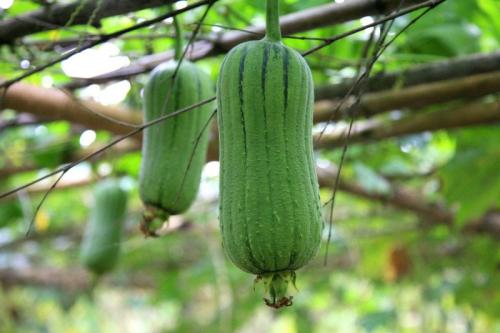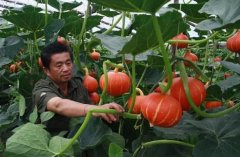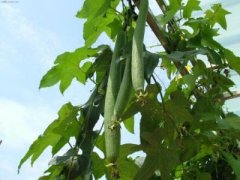Planting method and time of towel gourd: how to grow towel gourd? Seasons and methods of planting towel gourd
Luffa is a relatively common vegetable, in the summer market when sold, is a popular vegetable, luffa is a vine annual herb, monoecious flowers, fruit cylindrical or angular, soft when the fruit is not ripe can do vegetables edible, mature fiber developed inedible, but fiber such as sponge, can do luffa. How is it grown? Let's take a look.

cultivation and management
(1) Cultivation methods: There are usually three kinds of tunnel shed, horizontal shed and creeping type, each cultivation method has its advantages and disadvantages, and should choose one cultivation according to its own land conditions. 1. Tunnel shed can imitate balsam pear cultivation for single ridge, to facilitate irrigation, usually with two ridge ditch spacing frame tunnel shed. 2. Although the horizontal shed is vulnerable to wind disasters, it is well ventilated and has sufficient sunshine, which is conducive to flowering and fruiting. The fruit shape is correct and the disease occurs less. 3. Although the creeping type does not require the cost of setting up a shed, it is difficult to effectively control diseases and insect pests once they occur, and if the melon leaves are too lush, it will not only become a habitat for fruit flies, but also poor flowering and fruit setting.
(2) Soil preparation: According to various cultivation methods, tunnel shed type can imitate balsam pear, creeping type can imitate watermelon, horizontal shed is different according to the type of crops before it, not necessarily the whole garden re-ploughing, planting hole type can be used after applying base fertilizer.
(3) Sowing: The best sowing time is around early February, sowing before early February, and the temperature is cold. The breeding period is generally 25 - 30 days.
(4) planting density: loofah growth period is long, and there are many vines. In order to avoid too luxuriant stems and leaves and not easy to bear fruit, the following row spacing can be adopted. Cultivation method Row spacing (m) Plant spacing (m) Description Creeping type 3.0 1.0 Single row planting beside furrow, leaving one plant per hole Horizontal shed type 2.5 1.2 Single row bed, leaving one plant per hole Tunnel shed type 3.0 0.9 ~1.2 Double row planting, leaving one plant per hole At present, the main cultivation method of farmers is tunnel trellis single vine dense cultivation, bed width 4 meters, plant spacing 0.45 meters. The female vine is allowed to grow and bear fruit, and the child vine (lateral bud) is completely removed, which not only prolongs the harvest period, but also improves the yield.
(v) Fertilization: The growth period of loofah is long, so it should be applied with late-acting organic compost and appropriate quick-acting fertilizer. The amount of fertilizer applied per 10 acres is as follows: Fertilizer total amount base fertilizer topdressing Ⅰ Ⅱ Ⅲ Ⅳ Ⅳ compost sulfate calcium superphosphate potassium chloride 2,000 48 55 25 2,000 -- 55 --- 10 --5 --10--5--10 -- 5 -- 8 -- 5 The first topdressing is applied 7~10 days after planting, and the second topdressing is applied in strips and cultivated soil at the time of vine pulling. The third time is when the vine grows 60 cm, the fourth time is when the first female flower of the seed vine blooms, and the fifth time is applied according to the growth and fruiting situation.
(6) Training: In order to promote the elongation of the female vine during flat shed cultivation, it is advisable to remove the child vine between the root and the main vine 1 meter early, until the main vine grows to the horizontal shed, and pick the core at 1.3 meters to facilitate the growth of the child vine on the horizontal shed. At this time, the vine can be induced to develop evenly, so as to avoid dense vines and hinder ventilation and light transmission, reduce disease occurrence and improve fruit setting rate. When planting single vine closely, the mother vine shall be allowed to grow and bear fruit, and the child vine (lateral bud) shall be removed completely.
(7) Irrigation: In order to promote the growth and development of tender fruit, proper amount of irrigation is required. If there is lack of water, not only the growth is poor, but also the development and quality of tender fruit are poor. Generally, furrow irrigation is implemented. Irrigation time is appropriate in the evening.
- Prev

Pumpkin Planting Technology and Management: When to Plant Pumpkins? Can you make money growing pumpkin?
Pumpkin can be planted in two seasons, spring and autumn. Spring planting is in January, and the growth period is about 110 days. Autumn planting is in September, and the growth period is about 80 days. Can you make money growing pumpkins? There is money to be made. If the planting is good, each mu can earn a profit of about 10,000 yuan, so
- Next

Planting method and time of towel gourd: seedling raising technology of towel gourd in early spring, how to plant towel gourd
There are many kinds of towel gourd, and most people will plant early spring towel gourd, because this will go on the market much earlier than the usual towel gourd, which will meet the market demand and have high income. Do you know the method and time of planting early spring towel gourd? Want or not
Related
- A one-day flower show brings 130 million yuan in orders! Nanhai, this Phalaenopsis exhibition is amazing
- What do the flower language and meaning of Lutheran tree mean? Precautions for planting Lutheran tree
- Encounter Chaoshan Kongfu tea, not without this cup of Phoenix single clump
- The durian market in Vietnam and Thailand is flooded. The price of imported durian has plummeted by 30-40% in a month.
- Shanghai solved the problem of local vegetable supply by planting 80,000 mu of green leafy vegetables.
- Wageningen University has become the best agricultural university in the world for the seventh time in a row.
- The strongest export season of South African grapes is full of challenges, with exports to Russia falling sharply by 21%.
- Sri Lanka is on the verge of bankruptcy, "Tea for debt" Organic Agriculture Revolution aggravates the Food crisis?
- Turning waste into earthworm manure and worm manure into organic fertilizer-A new choice for auxiliary farming
- Organic rice growers shoulder the responsibility of nurturing agricultural talents! Yinchuan Sustainable Farm with Organic Life Camp

